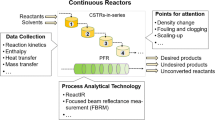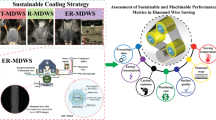Abstract
Purpose
A template to prepare a business case for Process Analytical Technology (PAT) and Continuous Manufacturing (CM) projects is presented in this study. Business cases are necessary tools used in different organizations to present new projects for management evaluation. As new ways of working under PAT and CM constitute a significant investment of capital, time, personnel, and other resources, a solid business case will facilitate the organization, presentation, and justification of these innovative strategies to management for their evaluation. The authors understand that this is the first study that considers the implementation of PAT in a specific manufacturing facility, including potential tax benefits associated with the manufacturing location.
Methods
A financial analysis template was used to develop a business case for an innovative stream sampler for pharmaceutical powder blends. The business case financial model included the capital investment and associated costs for implementing this powder sampler. The case study modeled three different potential tax benefits modalities. The definition of the financial model parameters, assumptions, and constraints are followed by the recommendations of pharmaceutical industry leaders and tax advisors.
Results
The financial model provided the evaluation of the listed relevant costs and benefits. The analysis evidenced a significant influence of tax incentives on the economic evaluation. As a result, the financial model estimated a net present value (NPV) range of $420,957 to $578,896, an internal rate of return (IRR) with a minimal of 65% and a maximum of 89%, and a return of investment (ROI) of 82 to 133% for the proposed PAT investment. The most significant benefits representing additional savings between $14,157 and $234,157 per year were presented applying the tax incentives.
Conclusion
The PAT Business Case template facilitates evaluating different scenarios, costs, and benefits for a proposed project. Each company may adopt the business case model according to its cost structure and manufacturing processes. The tax benefits contribute further to this case study, especially the super deduction, followed by the R&D tax credit. Furthermore, the tax incentives effects can be evaluated by entering the input data without an additional step in the business case template.



Similar content being viewed by others
Data availability
All data is available as supplementary material of this article.
References
U.S. Department of Health and Human Services FDA. Guidance for Industry - PAT A Framework for Innovative Pharmaceutical Development, Manufacturing, and Quality Assurance. 2004;1–19.
Fontalvo-Lascano MA, Méndez-Piñero MI, Romañach RJ. Development of a business case model for process analytical technology implementation in the pharmaceutical industry. Proceedings of the 5th NA International Conference on Industrial Engineering and Operations Management. Detroit, Michigan: IEOM Society International. 2020;1144–52.
Qaid WAA, Finaev VI, Tychinsky AV. Algorithmization of the process of preparation of capital investment project. Mediterr J Soc Sci. 2015;6(2):354.
Maes I, Van Liedekerke B. The need for a broader perspective if process analytical technology implementation is to be successful in the pharmaceutical sector. J Pharm Innov. 2006;1(1):19–21.
Kourti T, Davis B. The business benefits of quality by design (QbD). Pharm Eng. 2012;32(4):1–10.
Stratton M. Business case development guideline. Crystal Ball User Conference. 2004;1–24.
Aithal S. An effective method of developing business case studies based on company analysis. Economics Educator: Courses. 2017.
Muzzio FJ, Robinson P, Wightman C, Brone D. Sampling practices in powder blending. Int J Pharm. 1997;155(2):153–78. https://doi.org/10.1016/s0378-5173(97)04865-5.
Berman J, Schoeneman A, Shelton JT. Unit dose sampling: a tale of two thieves. Drug Dev Ind Pharm. 1996;22(11):1121–32. https://doi.org/10.3109/03639049609065948.
Esbensen KH, Román-Ospino AD, Sanchez A, Romañach RJ. Adequacy and verifiability of pharmaceutical mixtures and dose units by variographic analysis (Theory of Sampling) – A call for a regulatory paradigm shift. Int J Pharm. 2016;499(1–2):156–74. https://doi.org/10.1016/j.ijpharm.2015.12.038.
U.S. Department of Health and Human Services FDA. ANDA's: Blend Uniformity Analysis; Withdrawal of Draft Guidance. 2002.
Prescott JK, Garcia TP. A solid dosage and blend content uniformity troubleshooting diagram. Pharm Technol. 2001;25(3):68–88.
Esbensen KH. Introduction to the theory and practice of sampling. Chichester, West Sussex PO18 0HY, UK: IMP Open. 2020.
Cogdill RP, Knight TP, Anderson CA, Drennen JK. The financial returns on investments in process analytical technology and lean manufacturing: benchmarks and case sudy. J Pharm Innov. 2007;2(1):38–50. https://doi.org/10.1007/s12247-007-9007-x.
Freeman SC, Gujral B, Rufino D. Building a business case for PAT. Pharma Manufacturing. 2007.
Valþórsson H. PAT implementation in pharmaceutical manufacturing and its economical impact. University of Basel. 2006.
Markl D, Warman M, Dumarey M, Bergman E-L, Folestad S, Shi Z, et al. Review of real-time release testing of pharmaceutical tablets: State-of-the art, challenges and future perspective. Int J Pharm. 2020;582:119353. https://doi.org/10.1016/j.ijpharm.2020.119353.
BioPhorum. In-line monitoring/real-time release testing in biopharmaceutical processes prioritization and cost-benefit analysis. 2020;45.
Sierra-Vega NO, Romañach RJ, Méndez R. Real-time quantification of low-dose cohesive formulations within a sampling interface for flowing powders. Int J Pharm. 2020;588: 119726. https://doi.org/10.1016/j.ijpharm.2020.119726.
Newman DG, Eschenbach TG, Lavelle JP, Lewis N. Engineering economic analysis. 14 ed. Oxford University Press. 2020.
Zamfir M, Manea MD, Ionescu L. Return on investment – indicator for measuring the profitability of invested capital. Valahian Journal of Economic Studies. 2017;7(2):79–86. https://doi.org/10.1515/vjes-2016-0010.
Klemm A, Van Parys S. Empirical evidence on the effects of tax incentives. Int Tax Public Financ. 2012;19(3):393–423. https://doi.org/10.1007/s10797-011-9194-8.
Jones Lang LaSalle (JLL). Life Sciences Manufacturing Report Puerto Rico. Invest Puerto Rico. 2020;36
Sierra-Vega NO, Román-Ospino A, Scicolone J, Muzzio FJ, Romañach RJ, Méndez R. Assessment of blend uniformity in a continuous tablet manufacturing process. Int J Pharm. 2019;560:322–33. https://doi.org/10.1016/j.ijpharm.2019.01.073.
Hill AM, Barber MJ, Gotham D. Estimated costs of production and potential prices for the WHO Essential Medicines List. BMJ Glob Health. 2018;3(1):e000571. https://doi.org/10.1136/bmjgh-2017-000571.
Hopp WJ, Spearman ML. Factory physics. Waveland Press. 2011.
Harrington TS, Alinaghian L, Srai JS. Making the business case for continuous manufacturing in the Pharmaceutical Industry. Proceedings of the 25th Annual Production and Operations Management Society (POMS) Conference, Atlanta GA. 2014.
Puerto Rico House of Representatives. Act 60. Puerto Rico Incentives Code. San Juan, Puerto Rico. 2019.
U. S. Internal Revenue Service (IRS). How To depreciate property. In: Treasury US Dot, editor. 2015.
Corredor C, Lozano R, Bu X, McCann R, Dougherty J, Stevens T, et al. Analytical method quality by design for an on-line near-infrared method to monitor blend potency and uniformity. J Pharm Innov. 2015;10(1):47–55. https://doi.org/10.1007/s12247-014-9205-2.
Sierra-Vega NO, Romañach RJ, Méndez R. Feed frame: The last processing step before the tablet compaction in pharmaceutical manufacturing. Int J Pharm. 2019;572: 118728. https://doi.org/10.1016/j.ijpharm.2019.118728.
Vargas JM, Nielsen S, Cárdenas V, Gonzalez A, Aymat EY, Almodovar E, et al. Process analytical technology in continuous manufacturing of a commercial pharmaceutical product. Int J Pharm. 2018;538(1–2):167–78. https://doi.org/10.1016/j.ijpharm.2018.01.003.
Green RL, Thurau G, Pixley NC, Mateos A, Reed RA, Higgins JP. In-line monitoring of moisture content in fluid bed dryers using near-IR spectroscopy with consideration of sampling effects on method accuracy. Anal Chem. 2005;77(14):4515–22. https://doi.org/10.1021/ac050272q.
Romañach R, Joubert Castro A, Esbensen K. What are sampling errors what can we do about them? Part 1. Spectrosc Eur. 2021;33(2):7.
Guenard R, Thurau G. Implementation of process analytical technologies. Process Analytical Technology. John Wiley & Sons, Ltd. 2010;17–36.
Moran F, Sullivan C, Keener K, Cullen P. Facilitating smart HACCP strategies with process analytical technology. Curr Opin Food Sci. 2017;17:94–9. https://doi.org/10.1016/j.cofs.2017.11.003.
Esmonde-White KA, Cuellar M, Uerpmann C, Lenain B, Lewis IR. Raman spectroscopy as a process analytical technology for pharmaceutical manufacturing and bioprocessing. Anal Bioanal Chem. 2017;409(3):637–49. https://doi.org/10.1007/s00216-016-9824-1.
Murphy T, O'Mahony N, Panduru K, Riordan D, Walsh J. Pharmaceutical manufacturing and the quality by design (QBD), process analytical technology (PAT) approach. 27th Irish Signals and Systems Conference (ISSC): IEEE. 2016;1–7.
Sánchez-Paternina A, Sierra-Vega NO, Cárdenas V, Méndez R, Esbensen KH, Romañach RJ. Variographic analysis: a new methodology for quality assurance of pharmaceutical blending processes. Comput Chem Eng. 2019;124:109–23. https://doi.org/10.1016/j.compchemeng.2019.02.010.
Acknowledgements
This study was financially supported by the U.S. Economic Development Administration (EDA) (Investment No.: 01-79-14889). The authors would like to thank several pharmaceutical industry leaders, CPA María de los Ángeles Rivera, tax advisor at Kevane Grant Thornton company, and Víctor Merced Amalbert, chief business development of the Department of Economic Development and Commerce (DEDC) of Puerto Rico, who provided valuable insights for the development of the business case.
Funding
This research is funded by Economic Development Administration, Award Number: (01–70-14889).
Author information
Authors and Affiliations
Contributions
MAF-L: Coordinated this research and carried out all experiments, data analysis, and drafted the manuscript. BBA-H: Drafted the manuscript, prepared figures, and data analysis. CC: Aided in manuscript revisions and establishing theoretical data needed. EJS: Aided in manuscript revisions and establishing theoretical data needed. MIMP: Coordination of the research, helped establish methods for data analysis, and aided in the conception of the study. RJR: Conceived this study and participated in coordinating the research.
Corresponding author
Ethics declarations
Consent for Publication
All the authors mentioned in the manuscript have agreed for authorship, read, and approved the manuscript and given consent for submission and subsequent publication of the manuscript.
Conflict of Interest
The authors declare no competing interests.
Additional information
Publisher's Note
Springer Nature remains neutral with regard to jurisdictional claims in published maps and institutional affiliations.
Supplementary Information
Below is the link to the electronic supplementary material.
Rights and permissions
About this article
Cite this article
Fontalvo-Lascano, M.A., Alvarado-Hernández, B.B., Conde, C. et al. Development and Application of a Business Case Model for a Stream Sampler in the Pharmaceutical Industry. J Pharm Innov 18, 182–194 (2023). https://doi.org/10.1007/s12247-022-09634-0
Accepted:
Published:
Issue Date:
DOI: https://doi.org/10.1007/s12247-022-09634-0




